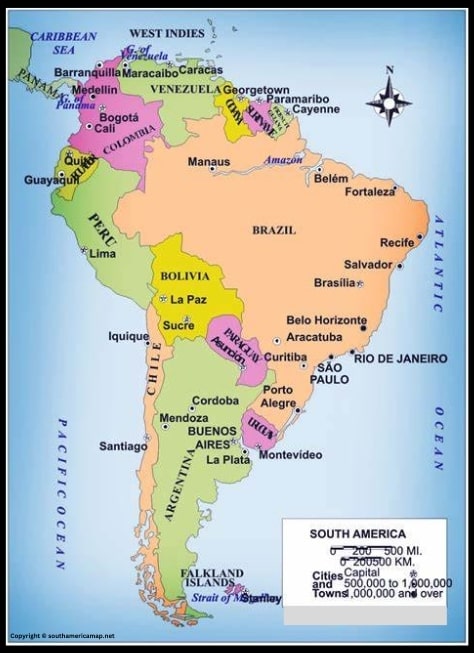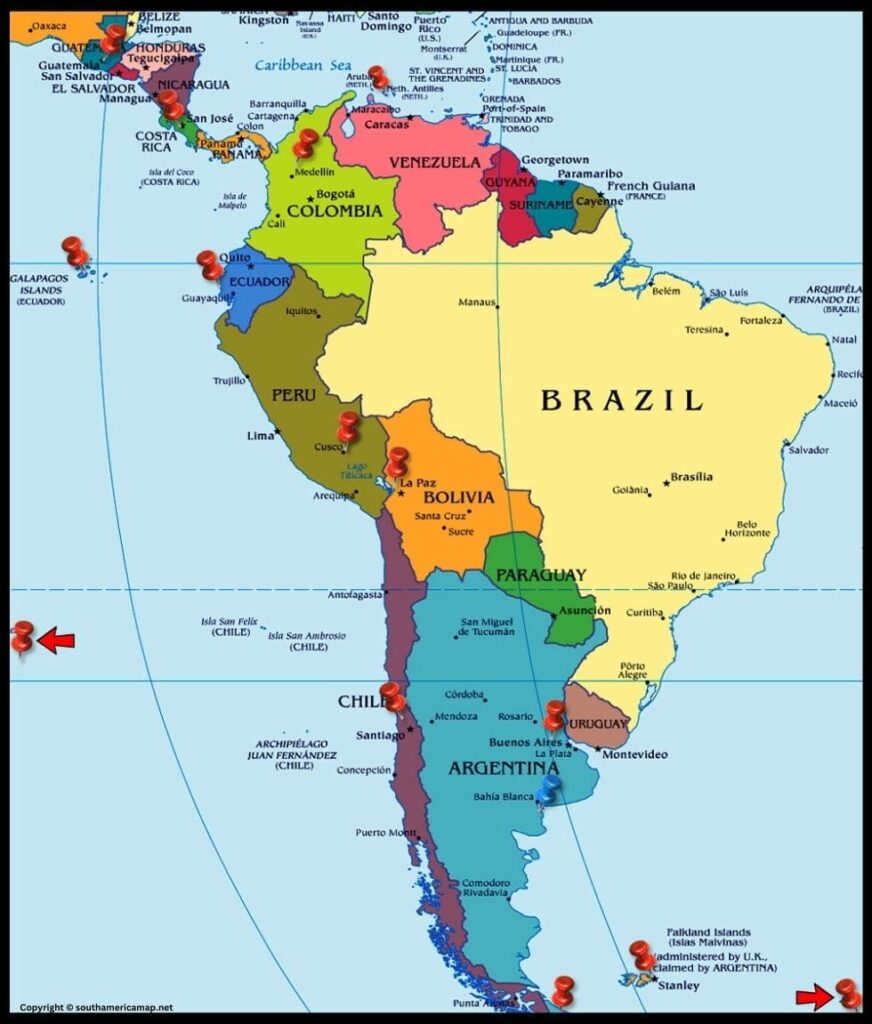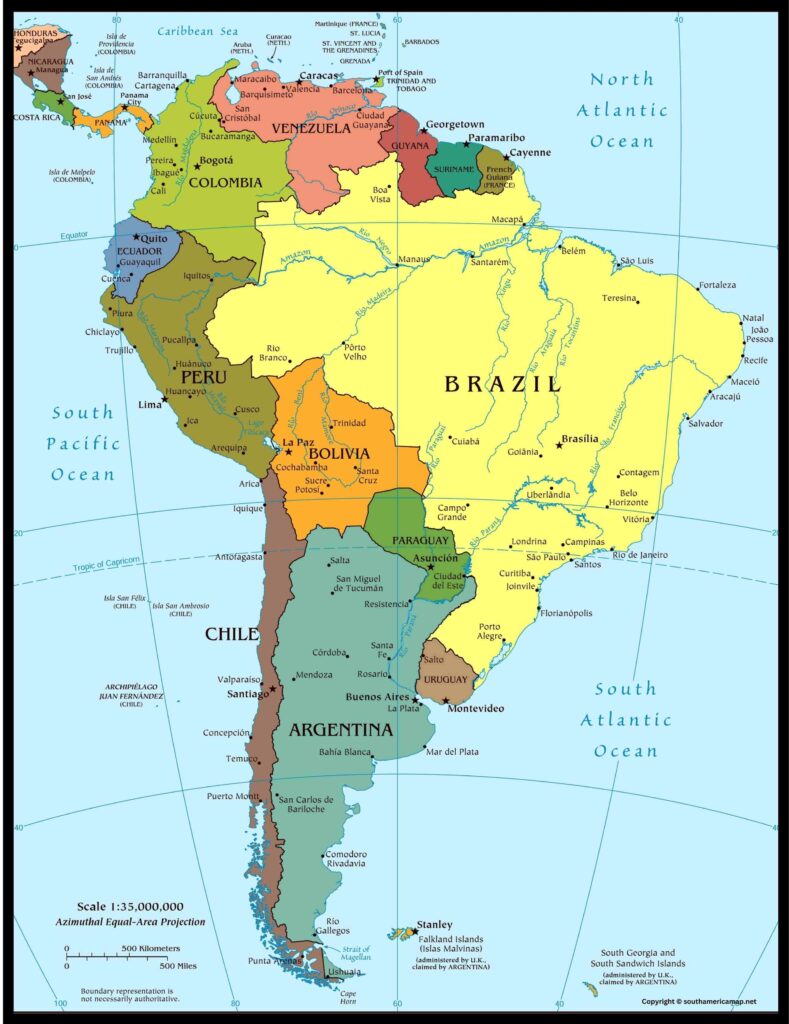The map of Central and South America is very important for several reasons including geographical, cultural, economic and political.
Related Post –
- South America Map with Capitals
- Physical Map
- North And South America Map
- Map of South America Countries
- Political Map
Central And South America Map
The following are some of the main points that focus on why the map of Central and South America is so important:
- Geographical Knowledge: Map provides a clear visual image of geographical characteristics, such as mountain range (eg, ends), rivers (eg, Amazon), and other physical characteristics, which help to gain better knowledge of the field topography.
- Political boundaries: Maps mark the political boundaries of all countries in Central and South America, which allows for understanding of sovereign states and neighboring countries.
- Cultural Diversity: Central and South America are culturally diverse areas, every nation has its own specific traditions, languages and inheritance. The map serves to display the prevalence of these cultural aspects throughout the region.
Central South America Map
- Economic relations: Map is important for learning about economic relations, business and distribution of resources. For example, the geographical location of the Panama Canal in Central America is important for international trade as it connects the Atlantic and Pacific Oceans.
- Biodiversity and Environmental Consciousness: Most of the diverse areas on the planet Central and South America claim some of the diverse areas, such as Amazon Rainforest. The map can be used as a means of indicating areas of ecological importance, promoting environmental consciousness and protection.
- Tourism and Travel: Map helps passengers and tourists to explore important sites, cities and natural points in organizing their journey programs. Whether ancient ruins visits or mountain climbing in Andes in Central America coordinate the map journey process.
- Educational objective: Within the academic environment, map is an important tool for geography, history and lessons of cultural studies. This helps students to achieve the overall approach to the compatriots of the region.
- Global Insight: Knowledge of Geography and Geography of Central and South America is a part of a large global insight. It makes countries, companies and individuals realize the world’s interdependence and makes a well informed decision.
- Human and crisis management: During natural disasters or human emergency situations, a precise map is important to organize relief activities, understand the affected areas and deploy resources effectively.
- Political relations and diplomacy: Political diplomatic and policy makers use maps to move in political scenario, understand the dynamics of regional power and form a strategy for global relationships and cooperation.
South America Central America Map
Central America:
Geography:
- Location: Central America is a thin land bridge between North America and South America. It gives Mexico a border to the south of North and Colombia.
- Landforms: This region is marked by mountain range, volcanic activity and coastal Terai regions. Ruchi is the Sierra Madre mountain range and Central American volcanic arc.
Countries:
- Belize: Located on the eastern coast, is famous for its ruins and diverse ecosystems.
- Costa Rica: Famous for its biodiversity, rainforest and eco-tourism.
- Al Salvador: The smallest and most populous nation, which is famous for its Pacific Coast and Jwalamukhis.
- Guatemala: Abundant in Maya culture and history with various scenarios.
- Honduras: Where the Caribbean has ancient Maya ruins and Bay Islands.
- Nicaragua: Famous for Lake Nicaragua, the largest lake in Central America, and volcanic landscape.
- Panama: Famous for the Panama Canal, which connects the Atlantic and Pacific Oceans.
Central America South America Map
South America:
Geography:
- Location: South America is a continent located in the Western Hemisphere, mainly in the Southern Hemisphere.
- Landforms: The west is characterized by Andes Mountain System, Amazon Renforest in the north, Highlands of Brazil and the broad plains of the Pampas in Argentina.
Countries:
- Argentina: Famous for its various scenarios, from the ends to pampa and vibrant cultural life.
- Brazil: South America’s largest nation, Amazon is known for mythological beaches like Rainforest, Carnival and Copacabana.
- Chile: The western border of South America moves, its extended beach, is famous for the Andes and Atacama Desert.
- Colombia: Various culture and geography, with Andes, Amazon Rainforest, and Caribbean and Pacific Coast.
- Ecuador: Galapagos Island, Amazon Rainforest and Andes Mountains.
- Guyana: The only English -speaking nation in South America, is famous for its various ecosystems and Cateur Falls.
- Paraguay: Landlocked and famous for Gwani culture and Paraguay River.
- Peru: Famous for Machu Pichu, Andes and Amazon Rainforest.
- Suriname: Famous for its ethnic diverse population and ignored the natural landscape.
- Uruguay: Geographically small but culturally dense, emphasizing education and social welfare.
- Venezuela: Abundant, different landscapes, and a complex history of politics.
Overall, the map of Central and South America is an important means in an array of use, from educational objectives and cultural enrichment to economic policy-making, ecological protection and international cooperation.


